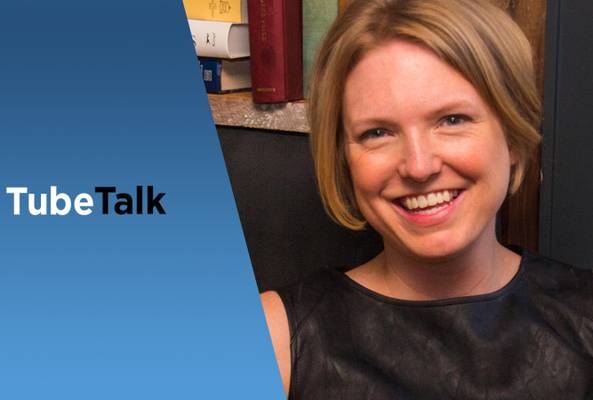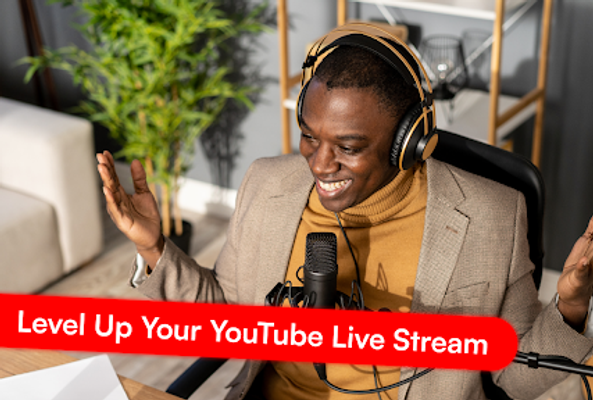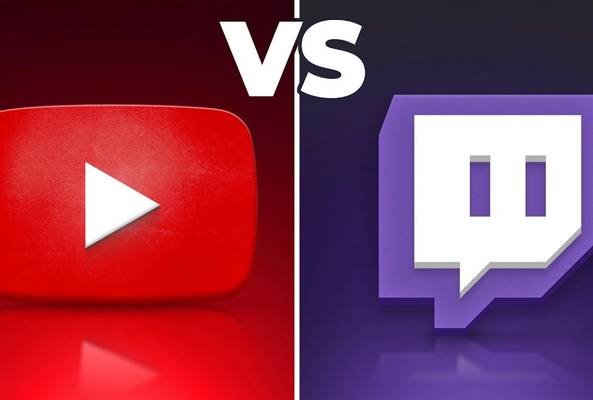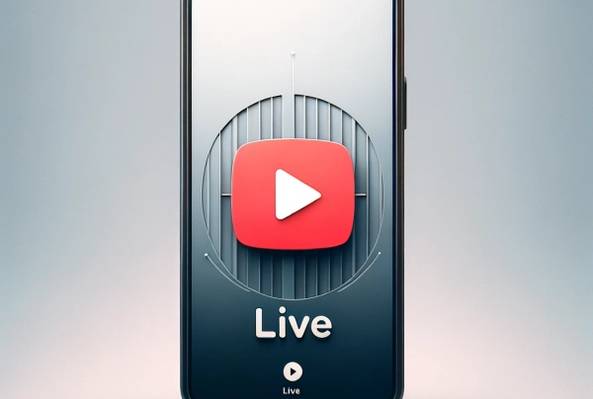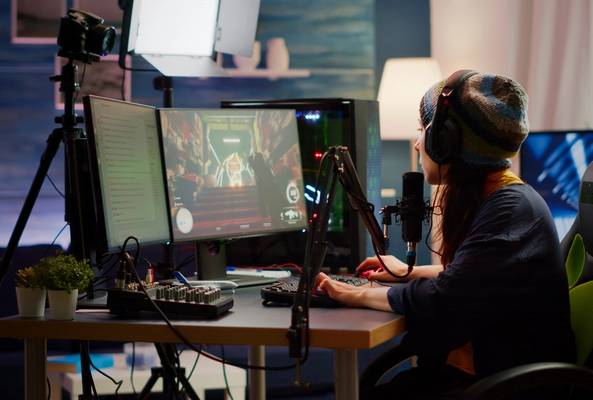Liron Segev, aka TheTechieGuy, is the Director of Customer Success at vidIQ, an internationally celebrated Digital YouTube Strategist working with some of the largest brands and YouTube influencers in the world. Over the past 20+ years, his work has taken him to South Africa, the UK, and the US where he frequently speaks at conferences and provides expert tech commentary for various print publications, radio, and TV while actively running his Tech YouTube Channel.
How to Win at Live Streaming Video: TubeTalk 178 with Luria Petrucci
Have you started live streaming on your YouTube channel yet? If not, why not? What's holding you back from pressing the Go Live button? And if you have gone live, are you looking to build a bigger audience to get those views and subscribers and spread your message even further?
Going live is one of those strategies that helps you reach out to a much broader audience to hopefully convert into subscribers. However, going live can seem a lot more intimidating to many creators than pressing a record button on your camera that you can edit later.
We’re joined this week by the guru of live streaming, Luria Petrucci, who will guide us through the whole process. Luria is a live video Strategist, who 13 years has created over 5,000 videos with over 1 billion views using video and live streaming shows. She’s worked on for top brands like AT&T, Samsung, GoDaddy, and Panasonic, and appeared on CNN, NBC, FOX, NBC, MSNBC, ABC & BBC, to talk about her specialist subject. In this podcast you will learn:
Stop Guessing. Start Growing.
Join 20M+ creators using vidIQ to get more views, subscribers, and success on YouTube.
- How to get over the fear of live-streaming
- How to maximise your live streamed content for future use
- How to prepare a winning strategy so you don't dry up
- How to use social to build an audience around your live streams
- How to keep the conversation going after the live stream has ended

Subscribe to TubeTalk: The Video Marketing Podcast!
TubeTalk has been informing video creators and marketers since 2014, and is one of the most respected and listened to podcasts in the online video industry. Subscribe today so you never miss an episode! You can find vidIQ's TubeTalk at:
How to Succeed at Live Streaming Video: Full Transcript
Liron Segev: Welcome to TubeTalk! Tell us a little bit about your background in live video.
Luria Petrucci: Oh, I'm so excited, I love chatting live! I help people create professional and authentic live videos, so that you can grow your audience and have an impact in the world. It was 2005 when I first started, and that was the early days of podcasting, and when podcasting meant video and audio. Now it just means audio. This was before YouTube was really a thing, so I actually didn't start YouTube for five years, because I was building my audience on iTunes, because that was the only option back then.
I did a tech show, starting back in 2005. It was recorded video, but I very quickly in 2007 dived into live video, and then started doing live video consistently for my own audience, using professional gear, really expensive gear at the time. It's brilliant how it's come down in cost.
I started with Leo Laporte, doing TV shows, and was co-hosting with him. And then, it was like, "Live video is where it's at, I got to start doing this," and so, I've been doing it since 2007 on a weekly basis or daily basis for myself, and then for Panasonic, and AT&T, and Samsung, and a variety of names.
So, yeah, it's been a long journey of different brands, different names that I've used over the years, and just a lot of exploration, in terms of live video, recorded video, and building audiences and communities.
Liron Segev: So, clearly, video's in your passion, you understand it. You seem to prefer the live, versus the recording. Is there a reason for that? Did something draw you specifically to that live kind of element of that?
Luria Petrucci: Yeah. I love live, because of the connection that you're building with your audience. It's an actual conversation, and an engagement. Live video is so freaking powerful, from a community perspective, and from a natural human being perspective, right? We desire, we don't desire, we need human communication as a human being. And so, that live video is the best way to connect with other people around the world, and build real friendships, without having to travel, and without having to be physically in the same place.
And so, that's why I love and focus on live video. I did video-only, video and live video for 10 years. And I still do a lot of video, but live video is definitely my passion, because of the power that lies behind it.
Liron Segev: And it's so funny how many people are so scared of the fact that you cannot edit. Whatever happens happens. But you need to embrace it. If you're going live, it's going to go wrong, and just own it, and just roll with it. That's how live, that's what happens in a live broadcast environment. How do you get people over that initial fear of, "Oh, if I press the Live Record button, or the Go Live button on my screen lab's IBS, or on my camera and my phone?
Luria Petrucci: You know, it's a decision. I totally get it, because I live it. I lived that fear, as well. So, back in 2005, when I recorded my first video, I called my mom crying, literally called her, crying. I was like, "I'm never going to make it. People are going to hate me." And of course, that didn't happen. And then, my live video, my first live video experience was on TV. It was crazy of me to just jump in the pool, right?
So I get it. I've lived that year, but the choice is, to do it or not to do it, right? So we all have fear, and fear is a natural instinct. It's a necessary part of our being. We use fear to stay safe, and to stay alive, but fear gets involved when it shouldn't. And so, we have to control our own brains, and say, "Okay. Is this going to hurt me physically? Am I going to die? Or am I going to just live through it, and have some uncomfortable moments?"
And with live video, let's face it, you're not going to die. So, you have to realize that fear is not a useful thing, in that moment. It's not trying to keep you safe, so you have to overcome that, by making a choice. And it's as simple as that. I don't know it doesn't feel as simple as that. But it's a choice, and you have to realize that you are in control, and you are in the power, you have the power to get over that fear.
Maybe not necessarily get over it. A lot of people don't ever get over it. I still, when I'm doing something new in live video, or I feel like it's a really important video that I need to make, and I really want to get our point across, am I going to say it right, am I going to screw up? I still feel that after 13 years of doing this stuff, right? So don't get over it, don't try and win at it. You win by just doing it anyway, and realizing that it's not going to kill you. It is just going to be an uncomfortable moment that we have to get past, and feel the fear through, right?
Liron Segev: Things are going to happen, but I'll be okay. Life will be fine. I've spoke to, with a lot of people who are going live for the first time, and their interpretation, it's just off the scale. I normally say to them, "What's the problem? What are you worried about?" Most of their responses have been, well, two things. One, that gear and technology's going to go wrong. It's going to let us down. And the second as being, what if nobody shows up? And that seems to be the worst fear. How do we deal with that?
Luria Petrucci: So, here, just to speak to those two things, and then, the other thing that people fear is, what people will think of them, right?
So, first, the tech. Guess what? It's going to go wrong! And with everything, when it comes to live video and all these fears, if you adopt fun as your attitude and your video, then you'll get through anything. You need to realize that the experience that you're providing your audience is the most important thing that you need to focus on, right?
So if you are providing an amazing experience, regardless of what happens with the tech or the tornado warnings or anything, then they're going to have fun. And they're going to enjoy it regardless. They love live, because anything can go wrong, so, enjoy the process.
Yeah, get good at the tech. Practice with the tech ahead of time, and understand what you're doing. When you go live, it may be the first time out, it may be the tenth time out, it may be the hundredth time out. Something disastrous happens and your stream goes down, but it's live, and it's going to happen. It happens to news stations, TV broadcasters, it happens to everybody. Just Google, and pull up "TV bloopers." You'll see, it's not you.
*Liron Segev: Oh, but that's a great point, though. Because we keep on forgetting that live wasn't invented by Google. It wasn't invented by Facebook. It wasn't invented by LinkedIn. Live was invented way back in the broadcasting days, when you had an on site broadcast, where your people went live on the scene, and things went horribly wrong, so that is a great way of looking at it. *
If they could mess this up so badly, and they're a team of 50 professionals, why are you putting yourself under so much pressure to be perfect, every single time? So that’s the tech issue - what about the scary thought of "I'm pushing live. I get zero people showing up."
Luria Petrucci: You should celebrate it! Because you know what? It gives you a chance to actually get good at it. In the beginning, it is very possible that no one shows up, if you don't have an already big audience, right? So it's going to happen. If you're just getting started, or you don't have a huge audience yet, you might get one person to show up. Treat that one person as your best friend.
Live video includes a whole lot of technical issues, it includes a lot of brain space, brainpower. You're multitasking. You're thinking about comments, you're thinking about the tech, you're thinking about what to say, you're thinking about what could go wrong. I call it the Live Adrenaline Monster, LAM, for short.
And yes, he's attacking, constantly, right? Telling you all the things that can go wrong, and he's just attacking your brain. And so, it's okay that no one's there yet. Treat it, at that point, as a video that you were doing in one take, and you're just going to power through it, you're going to mess up how you say it, and that's okay, because, hey, it's just, you're just doing it in one take. And if you say something, you just keep moving.
If there's no one there to engage with you, just wrap it up, like you would a normal video, and then, guess what? It becomes a regular video after the fact, and it's totally okay. If there's one person there, treat them as your best friend, really make them feel special, and prepare ahead of time, so that you know what you want to say, so that you're not thinking of it on the fly. And then, over time, you will grow your audience, and if you want, we can discuss that.
It's not a bad thing if no one shows up right away, because you got to figure it out in the first place.
Liron Segev: You know your five bullet points. You know what you're going to say. You kind of, you have an idea. Well, at least you should, by now. I mean, really. And then, when you go live, it's the same thing. Is there a show formula that you would advise people to have, or some idea of what they should say when? Or is it just as fluid as these kind of discussions?
Luria Petrucci: Yeah. And I can actually give this to you in an image. This is the structure. I call it the show flow. So it matches very closely what you would do in a recorded video, so you're probably familiar with most of it, right?
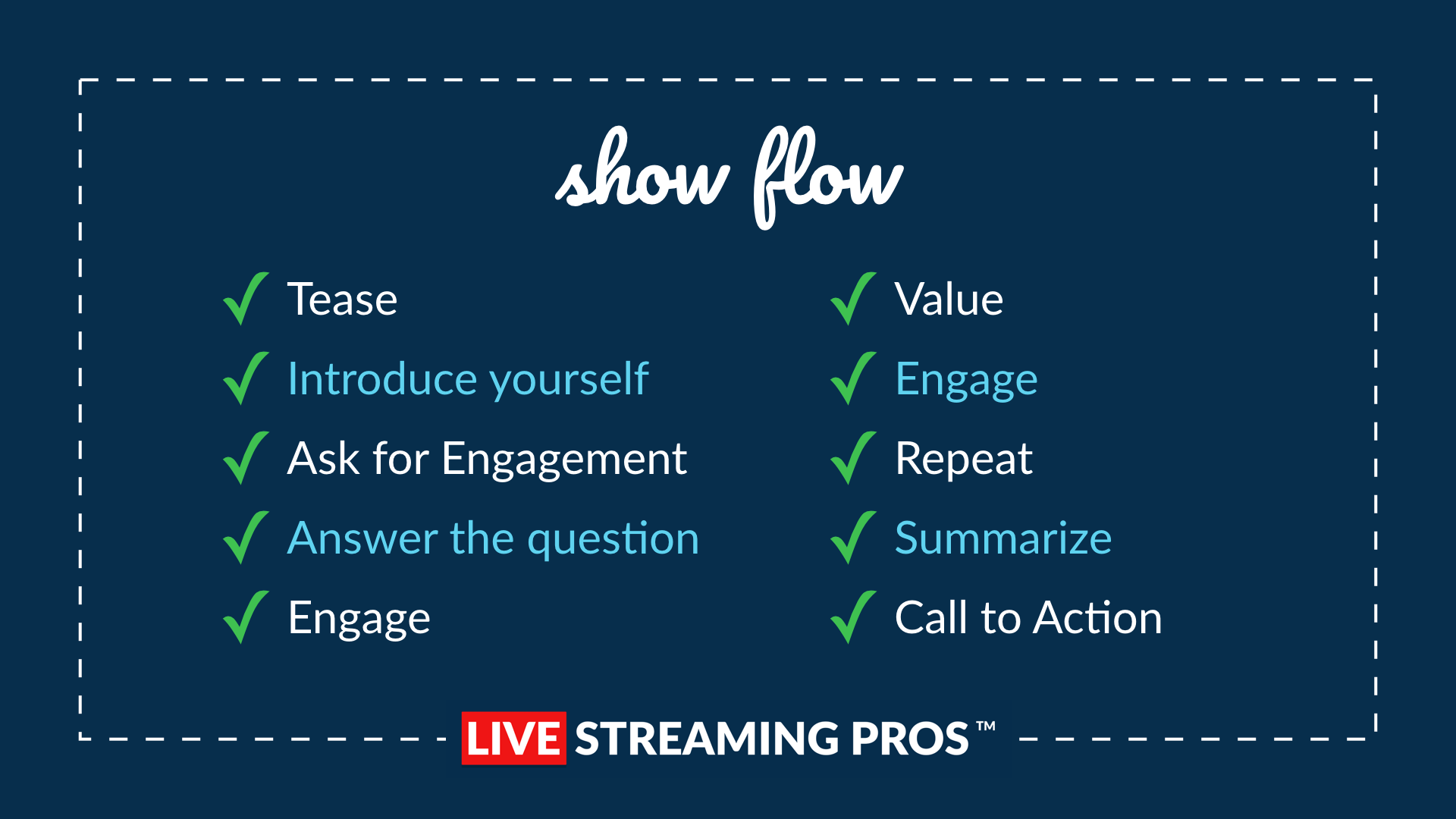
So you do want to prepare, you want to think, "All right. What do I want to say?" Try and break those things up into three steps, or three ways to accomplish something, or segment it out, so that you have break points. So that's that your preparation. When you go live, you start by intro, or teasing, "Hey," what are they going to learn? "I'm going to share with you today the secret to life. You're going to live to 200 years old." Okay?
You can tell them what they're going to get. Then introduce yourself, and ask a question. You'll play up the questions a little bit more than in recorded video. But you're going to ask a question of the audience, and this is more for the replay viewers than it is for the live audience, because by that time, you may not have a live audience, because this is going quickly, right, tease, intro, question.
And then, you maybe answer the question yourself. So there's a delay with live video. So any time you ask a question, just be prepared to wait, but you don't want to just wait awkwardly, right? It's so awkward when you make it, like, when you call out the silence, so be prepared to just answer that question yourself. "Hey, what's your favorite animal? For me, I know my favorite animal is chickens, and here's why."
And then, once you've answered that, look at the comments. You don't have to make a big deal of it. Just briefly glance at the comments. If there are other comments, then actually respond to the comments. Call people out by name, and say, "Oh, well, Liron says his favorite animal is dolphins." And then, if there's no comments, again, don't call it out, just keep moving into that first point that you want to make, right?
Focus on that point, and think of that as an engagement-free zone. Don't get distracted by comments. Deliver your information, deliver some value, if that's what you're there to do, and tell a story, or tell people how to do something, or whatever that value point is for you. And then, when you're done with that first segment, then you break for engagement.
The worst that you want, that you can do, and what you're trying to avoid by doing this segmentation process, is actually saying, "Okay. I'm going to give you the secret to life. If you want to live to 200 years old, you're going to buy... oh, my gosh, Sue, I can't believe you're here. Thank you so much for showing up!" Right?
Like, "Wait, hold on. What am I supposed to buy? Well, wait, what?" Okay? You're leaving the audience the audience hanging, and it's not a good experience, so you're just breaking it up. Giving the value, breaking for engagement. Then move on to segment two or point two or step two, however, you have it broken it up. Then engage. And then, you just, however many points you have, that's how you, how it flows. At the end, definitely a call to action, and maybe even wrap up the points. Repeat what they learned. And then, tell them where to find you, and subscribe, and all of that good stuff. And then end it.
So that's kind of the formula, the show flow that I like people to go through, because it's a really powerful way to get your brain space around it, and not leave room for, "Oh, my God, what am I supposed to say now?"
Liron Segev: The more you prepare, and the more you know your stuff, the easier this becomes. Which is why I could literally call you up with no warning, and say, "Hey, I want to ask you a question about love." And you go, "Yeah, shoot, what do you want to know?"
You won't need three days to research, because you know your stuff so well. If you're an expert in our subject that you're going live about, well, then, be the expert. But then deliver. I hate it when people drag the stuff out. "Well, we're just waiting for another five minutes. We're just waiting for another 30 more people."
Luria Petrucci: No. Don't do it.
Liron Segev: I don't have that kind of time. I'm here for a course. You told me, "It starts at 12:00, let's go at 12:00." One of the tricks that I like to do is to go live, kind of five minutes before the due time, when people are already starting to congregate in your chat. You're starting to already have that engagement. It just gives you a little bit of time to relax, make sure the audio's working, they can see you, you ask them questions, okay?
Well, if it was more to kind of break the ice, more, "Where are you from?" Kind of, "Tell me what nice are you in?", "What is your channel about?", that kind of format.
Luria Petrucci: There's really no point in asking those questions, "Can you see me?", "Can you hear me?" If you've tested your setup, and obviously, things can go wrong. But for the most part, you should just assume that your setup is good to go. If you see anything wrong, you'll fix it. If they see anything wrong, they will tell you. The audiences are great at doing that, right?
Liron Segev: Absolutely, okay. So, it's okay to kind of chat with them before you go live, but the thing is, just avoid the stupid question, like, "Is this thing on?"
Luria Petrucci: Yes.
Liron Segev: So one of the things that you've mentioned was, "I have my show formula, great. I'm now prepared, I'm on plan, I know what's going on. If nobody shows, I'm still going to deliver my message. I'm going to deliver my intro and my outro. It looks like a normal video, okay."
Luria Petrucci: This is a really important point to drive home. You said, "Treat it as another video on your channel." If you actually take what you just said to heart, then you are optimizing the heck out of your video before you go live. You're making sure that you have the right title. You're making sure that you have the right description. And then, trim off any of that pre-engagement, or afterwards, or anything like that. And we can talk about some examples, if you want, of people who do this well. But you want to treat it exactly like you would any other video on your channel.
Liron Segev: The one thing we need to remember, when you trim a live video on YouTube, you will lose the chat replay.
Luria Petrucci: That's true, yes.
Liron Segev: Unless that's super, duper, duper important and critical, which in most cases, it isn’t but just a heads up, it's worth noting, if you trim things off in YouTube, on a live video, you will lose that replay off the chat. If you got any example of somebody that does this really well, we would love to study that.
Luria Petrucci: Yeah, so, three people who do it really, really well, Sean Cannell, does live really well, from an education perspective. And there are different ways that you can do live well, right? So, he does it from an education perspective. He will actually go live. He gets right to the point. He does engage a little bit in the beginning, by calling some people out, but he doesn't spend a ton of time on that.
He gets right into the information, has slides, has visuals. He teaches, teaches, teaches, and then does Q&A at the end and really engages. So that's a different format that works really well for the host optimization, because at that point, people have no idea watching it on the replay, that it is a replay of a live, until they get to the end, where there's Q&A, right?
So that's one way. Nick Nimmin is another great person to look at, from a community-driven perspective. He does a show every Saturday, and he's live for six hours. it's a long stream, and it's Q&A-based, and it has a lot of fun factor built into it, super chats, hanging out etc... but he also does channel reviews, so there's a lot of value involved, as well. So, from a community perspective, it's a lot more relaxed. It still works for the replay, because people are still getting that massive value.
Liron Segev: Got it. Could you download a live video to your computer, once it's done on YouTube, once it's done processing?
Luria Petrucci: Yeah, absolutely.
Liron Segev: So then, you could then technically repurpose that content, and then use it elsewhere on other platforms, in square formats, things like that.
Luria Petrucci: Yeah. And you can, on any platform, if you're using the right software, you can record a copy to your computer. But, to be honest, even we rely on the YouTube video to just download it, so that we're not taking up processing power on our computer to record it.
Liron Segev: All right, so, let's recap. So we've got our setup. We're now trying to relax as humanly possibly. We're delivering lots of value. You've mentioned that some of these guys use slides. Do you recommend adding, kind of, a slides element for some visual impact, versus just like, a talking head?
Luria Petrucci: Depends on what you're trying to do, right? So the more visually you can do, the better. But it's not absolutely necessary. If you're trying to teach, or educate, do how tos, demos, things like that, you need a visual aspect. If you're doing Q&As... By the way, don't do Q&As if you're just getting started, and you don't know if you're going to have a live audience. That's the worst feeling in the world.
So only do Q&As live when you know that you will have an audience show up and ask questions. Or you can do pre-submitted questions, or you can plan out your FAQ, or something like that, those are alternatives.
If you are going to just do more hangout streams, and Q&As, and things like that visuals are less important but there's no one way to do live video.
Just as there's no one way to do anything in life, there's no one way to do this. It's how you want to supplement your existing content with live video. And so, you decide what you want to do with live, if you want it to be its own point of education, if you want it to be a community hangout, if you want it to be private for people who are Patreon members, right? There are multiple ways you can do it.
So what's your strategy? Decide that first, and then build on top of that, in terms of, "Do I need visuals or not?"
Liron Segev: Perfect, okay. So, and the key message is, there isn't one right way that absolutely you need to fit into that mold. I suppose different channels are going to have their own uniqueness, their own community. If you're a, I don't know, knitting channel, it's going to be different to a tech channel, different to another channel, and then, the audience is going to expect different items from you, as you deliver your live.
Luria Petrucci: Correct.
Liron Segev: Could you do live in virtually every niche?
Luria Petrucci: Absolutely, yeah. I mean, our students, they range from everything, and sometimes, I'm like, "What?" So it really can work in everything. The only thing it probably shouldn't work in is, like, if you're a spy, you know what I mean?
So, definitely, and we go live five days a week, at least. And three of those are public streams, and we do different formats, so that we can showcase the different ways you can do live video. So one is our mobile day, where we are out and about, with really high quality gear, and we're taking people on experiences. It's longer streamed, so it's IRL, and then, our Wednesday streams, they're shorter, they're more compact, they're really value-oriented.
And then our Friday streams are fun, and so, it's more like, Friday fun, where we are providing value, but we're also hanging out. It's very engagement-oriented, right? So we like to showcase the different styles of live, and then, our other two streams are private, for members, and we do those two different ways, as well, for them. So there are just a lot of different styles that you can play with, and it needs to match your personality, for sure.
Liron Segev: Right, and the energy that you bring. If you're going to be flat by, if you promised yourself you'd do three lives a week, and by the second one, you're absolutely done, your audience is going to feel that one.
Luria Petrucci: Oh yes.
Liron Segev: So do you find that this takes a lot out of you?
Luria Petrucci: Yeah. I mean, after 13 years, I'm pretty used to it. I do events, so, a CES or NAB show, where I'm live for eight hours a day. Our longest IRL stream is 13 hours. I've just learned how to just go, and just have fun, and power through it. But at the end of a eight-hour or 13-day, I'm tired, I'm puckered out, but some people thrive on live, like we do.
And that's why we teach it, right? So, but some people, it is more draining for, and so, at first, it's definitely going to be more draining. You're going to be, you get off, and you're either going to feel, "Hoo! Whoa! I need, I think it's one o'clock right now, right?"
Or you're going to be, like, "Whoa, it's so amazing, I'm so fired up, and ahh, this is awesome!" It goes one of two ways, right? And so, you need to pay attention to that. Now, once you get over the fear, and you once you're getting through all of the muddy waters in the beginning, then, that's when you really need to start to pay attention to how you feel about it. Because you're probably going to feel a little more drained at first, while you're dealing with all of the muddiness.
But once you're past that, you've done lots of them, then it just eventually becomes really addicting. Because you're having conversations, and it allows you to get the audience going, and you have conversations happening. It's just, it's firing. It fires you up. So, yeah, I mean, for us, it's not really any more draining than anything else we do, because we've been doing it for so long.
Liron Segev: Let's talk audience. How do we build an audience? What are some tips that you can gie us to really push that messaging out beyond the whole, just share it on social media, obviously?
Luria Petrucci: Yeah. So, first and foremost, we need to just make sure that we're all on the same page. It's going to take some time and it's going to take some consistency, right? Just like everything else, you need to be consistent. You need to have a live video show, same day, same time, every week, that people can show up to.
And, beyond that, once you're mentally prepared for that, you want to do the things that we talked about before, in terms of treating your video like any other video. So live should be optimized, it should be thought ahead of time, like, what is, what are people searching for, what do people want from me? So that you can catch people's attention when you go live.
Otherwise, if you're not really catching people's attention with the description, or the title, then you definitely are not going to see anybody pop onto... Because people are busy, right? So you have to really entice them.
Liron Segev: Would a good thumbnail strategy at this stage help here, as well?
Luria Petrucci: Yeah. Possibly, that's an area that we could work on, because we don't do it, because we go live so often, we don't really put more effort into our thumbnails until after.
Liron Segev: Yeah, but your community knows you by now so they know what you do. They basically recognize, "Okay, I've got to make time for this. This is going to be awesome." The rest of us, who are trying to go from zero to one…
Luria Petrucci: Yes.
Liron Segev: We need to remember that when you go live, you get that notification, it goes out to your subscribers, if you've already got a channel. If the thumbnail is awesome I think it's going to sell, help people bring people over.
All right. So now, I'm caught up. I've optimized, I've got my thumbnails, I've got my titles, my description, my tags, anything else I can do to prepare before I go live, to just grab my audience?
Luria Petrucci: Yeah. Just, all of the optimization things, the thumbnail, all of that is key. Make sure that if you have an Instagram account, and you have some followers on there, do stories leading up to it. You want to treat this as an event that you want people to show up to, right? So make sure that you work up towards it, right? So know what you're going to be talking about, a week in advance, and then, say it on your live stream for the next week.
Say, "Hey, by next week, that next week, we're going to be talking about this." On Instagram, go to User Stories, the day of and the day before, especially. Make sure that people know what's coming, that they have to join, give them an easy way to do that. And then, you can kind of work the party up, across social, across a e-mail list, if you have an e-mail list. You definitely want to invite your e-mail list.
So, all of the things, all of your assets. You want to think about your properties, your social properties as your assets: e-mail list, Twitter, Instagram, Facebook, YouTube, these are all assets that are vital to your promotion strategy ahead of time, and after.
Liron Segev: That was my next question. It's like, "Okay, so I've done this thing. I've got over my, this amazing fear, if people actually showed up. We had a lovely time, over there everything looks fine, I think I needed to do, like, a couple of shots afterwards to calm down, and I loved it. Do I then just leave it as is? Or is there something I should be doing, following the live stream, to kind of thank the community, or should I be doing something else?
Luria Petrucci: Yeah, I mean, you can do all kind of things. But from a promotional standpoint, you should definitely make sure, again, it's optimized, like you've already pre-optimized it, but maybe something changed. Or you talked about something, that you need another link in there, or hey, maybe it took a completely different turn, you need to re-optimize it. But make sure that everything's fine tuned.
Then, promote the heck out of it again. One great thing that you can do is, you said, thank your audience, right? So choose a one moment from the stream, and say, "Oh, man," go out on Instagram. Do another story, and be like, "Oh, man, you just missed this." I call it the "You missed it" strategy, the FOMO strategy.
And so, you say, "Oh, my gosh, you missed it. So and so did this amazing thing, or said this amazing thing," or, "We had this crazy cool conversation that led to this," or, "Hey, I fell off my chair while I was live, and you missed it." Create a story around something that happened, and share that, to help promote it after the fact. That way, you're not just promoting the same thing, it's a different angle.
Liron Segev: Oh, and stuff is going to happen in a live, and that's the whole thing about live. You could have the same show Monday, Tuesday, Wednesday, Thursday, Friday, and different things will happen at different days. The audience is going to be different, people are going to say different things, funny things are going to happen, horrible things are going to happen.
Luria Petrucci: Yeah.
Liron Segev: That's why I love that you've been able to capture that, and say, "Oh, my God, I cannot believe you missed it. This is what happened." That's going to make someone go, "Oh, I need to be on the next one. Why did I miss that?"
Luria Petrucci: Exactly. And maybe even clip it, right? Take a video editor, and clip just that piece that you want to showcase, and put that on Twitter as a gift, or something, right? You can share in multiple different ways, so get creative in this process.
Liron Segev: Well, that’s why people like live so much? Because it's raw, because it's not overly produced, because it's not perfect. I was watching one of your streams. You guys were out in a park somewhere, you were setting up, everything was going well, and then, somebody opened, had a birthday party next to you in the middle of your screen. And it all went belly up. But you know what?
*But what was awesome is that you didn't lose people in that live stream. People were just saying, "Hey, no problem! Let's go for a walk with the dogs, and we'll hang out here." And that was the beauty of those. It wasn't, but it was, "Cut, action, clip!", and then it's done. It was just you guys. And it was us all hanging out, and then it felt like we were all there together, literally just hanging out. *
Luria Petrucci: Yeah, a key component to that is, I would have lost viewers, had I had this reaction: "Crap! Oh, my God, I won't be able to now do this! What am I going to do? I'm so sorry, guys, I know you can't hear me, because of this fricking party going on over here. Oh, man, our life sucks!" Which, honestly, is the way a lot of people actually react, when things go wrong. They apologize or over-apologize, they freak out, but the approach was, going back to that whole experience, we're creating the experience based on our reactions to what happens. And so, again, you are in control of everything. You just need to make sure that you are creating what you want.
Liron Segev: Yeah. And I think that's so, so, so key for live. You're in charge, you're making it happen or not happen. People are going to react to you, and how you react to whatever's going on. When that tornado thing hit, I said to the audience, I said, "Okay, we're still going to do this, but if anything falls on my head, please phone my insurance company and give them a clip." You know? Lots of LOLs in the chat, lots of, "Are you sure you want to do this? Is everything okay?" And we're going, "No, it's just a tornado. What's a little wind could do?" And then, we just went with it.
So we started a little bit late, and it was perfectly fine. People wanted to kind of understand a better way of doing live. Because I think we all agree that live is going to get better, not worse. The technology's getting easier, it's getting cheaper. I think a lot of the platforms are going to start embracing more and more of live, as LinkedIn has recently. Should live really be part of our kind of content strategy, if not now, in the future?
Luria Petrucci: Yes, absolutely. And now is better, because you'll be ahead of the curve. So, the one thing that will never change with live is that fear for people. Because it's just, it's live, and people always fear what they can't control. But you've learned now today that you can control it. You just have to have the right attitude. I will say that the generation growing up now, it fears it a whole lot less. So they will certainly kind of come into it a little bit more naturally.
Because they're on Instagram, they're taking photos, they're doing stories, and by the way, that's one of the easiest ways used to doing live, is doing 15-second stories throughout the day. So I would say, get into it now, so that you're getting through that process, getting good at it, while it's still an early adopter thing.
Liron Segev: Should live be part of the strategy, not just for content, but maybe part of the strategy of growing your subscriber base, or growing your followers, or growing, oh, even doing sells within your business?
Luria Petrucci: Yes, yes. yes, yes, yes, yes!
Liron Segev: Finally, before we wrap up, if people wanted to find you, they want to get more information, what's the best way to do that? This is my plug myself moment.
Luria Petrucci: So, we are on all the channels, under Live Streaming Pros, at Facebook and YouTube, LinkedIn, and Instagram, under my name. If you can spell Luria Petrucci, more points to you. And then, we also have a community called Cre8live.com, where we are creating the place to be for live streamers, so that you can get support emotionally, training, community connection. We brainstorm a lot about how to fix problems, and what to do in this scenario or that scenario and the new things that you can do. And just, it is the community to be in, for live video.
So we're getting a whole bunch of influencers involved as well. So it's a cool space, outside of all these platforms with our algorithms.
*Liron Segev: Luria, always fun, always a pleasure. Thank you for making the time and sharing so much with us. Really appreciate it. *
Luria Petrucci: My pleasure, I had a blast, thanks.
Want To Get More Views on YouTube?
If you want to take your YouTube channel to the next level and get more views on YouTube then make sure to download vidIQ. Join over 1 million other users and use vidIQ to help you research YouTube, analyze videos, audit your own channel, and take actionable steps click here to install now!
20k+ 5 Star Reviews
Ready to put this into action?
Use vidIQ to find your next video idea, pick better keywords, and optimize every upload.

